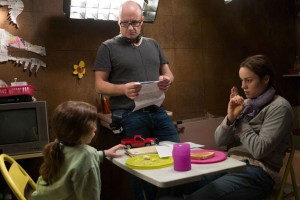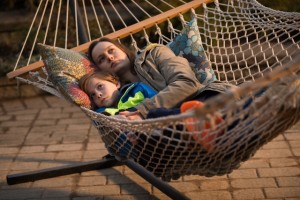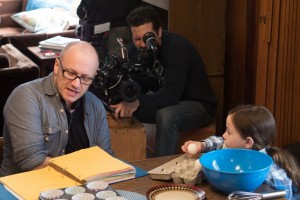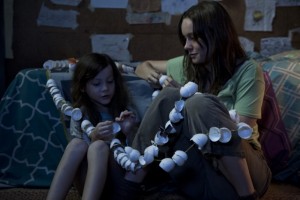 Interview - Lenny Abrahamson, the director of “Room” (2015)
Interview - Lenny Abrahamson, the director of “Room” (2015)
In director Lenny Abrahamson’s “Room”, he tells the story of a young mother (Brie Larson) and her 5-year-old son (Jacob Tremblay) who reside in a very cramped, one-room space. The movie initially presents the circumstances of their odd living situation as a confusing puzzle, but eventually, the secrets of “the room” are revealed. Lenny chatted with the Phoenix Film Festival – in an engaging discussion - about his new movie, the relationship with Brie and Jacob and their characters’ connections. There is one spoiler which came up during the last question of the interview, but I will warn you ahead of time. “Room” won the People’s Choice Award at the 2015 Toronto International Film Festival, and it opens on Oct. 23.
PFF: The film did a masterful job of slowly revealing the secrets of the room. It certainly is a mystery at first, so how important was it to present one day in the room – specifically Jack’s (Tremblay) birthday – as an initial setup?
LA: Very important. The big part of the first phase of the film is that first day, because I wanted to gradually show the audience the full extent of the situation, and that took one 24-hour period. You get the entire routine, and it was also important for the reveal to be slow because I wanted the information to flow to the audience as it flows for Jack. The room is a place of routine, safety and comfortableness with his mother. It’s all he knows. (I am) just tracking their lives “naively” as a filmmaker. I am a huge fan of an implied filmmaker who tries to understand, rather than desperately project a whole series of experiences that are prepackaged. That’s pretty much how I did it.
PFF: I appreciated the contrast between Ma and Jack. There were differences in a many areas, but the two which stood out to me

were resiliency and optimism, because of their different life experiences. When do you think we lose resiliency and optimism as adults? Do you think Ma lost them prior to her situation in the room?
LA: That’s a really interesting question. That’s not one I’ve heard before, but it is really at the heart of the film. “Room” is about a relationship, so I can particularly talk about each of them in relation to the other, but in this situation, the mother has two definite faces. She has the face that she turns towards Jack, which is reassuring, which is fun and one which tells him all the time that nothing is wrong and everything is okay, and then you have the face when he is not looking at her. You feel what she is really going through.
We all do that with our kids. We create a bubble around them, we are warm and we are as optimistic as we can be, even when stuff is going wrong in our lives. I think what is fascinating is that bubble is never complete. I think, very quickly, kids do sense the shadows in their parents’ lives. It is a slow process of the demythologization of moving to the reality, the complexity and the shadowiness of the adult world. I think Ma was probably this pretty ordinary teenager. Very self-centered, still not really a full-adult, but I think in a way, her development is arrested when she goes into that place (the room).
 PFF: One of the pleasures of the film is Jack’s narration, as he explains the way he sees the world. What lessons can adults take by looking at life through a kid’s eyes?
PFF: One of the pleasures of the film is Jack’s narration, as he explains the way he sees the world. What lessons can adults take by looking at life through a kid’s eyes?
LA: I think the main thing is he is not aware that he is missing anything, and that allows him to make the absolute most out of the small amount of stuff that he has. I think we learn something as parents from this, which is we obsess about our children’s lives. We want them to do all of these extracurricular activities, we obsess whether they are watching too much TV, whether they have enough music lessons, and all this stuff that we get into as parents, and most of which has very little bearing. Mostly it’s just about providing them with love and a sense of safety, and kids can do the rest with very, very minimal resources.
I think for adults as well, we fantasize ourselves into ideal other lives all the time. This film says to you, “Well, there is probably a tremendous amount (of goodness) in the life you’re leading. If you just calm down and take a look at it, it is wonderful.” I think that’s a good thing to keep in mind.
PFF: Brie and Jacob shared plenty of on-screen, mom/son chemistry. How did they spend time together prior to shooting? 
LA: We did get them together for – in film terms – a lot of time. We had three weeks before we started shooting with both of them together. Some of that time was taken up with wardrobe settings and wig-work, but the bulk of the time – certainly the first week – was just hanging out. All of us (hung out), so Jake (Jacob) wouldn’t feel pressure to form a friendship with this person. He’s a smart kid, and he knew this was the person with whom he would be acting with for quite a long time.
We just went out for pizza, and we all sat around together. He gradually started asking Brie questions. What her favorite “Star Wars” character is? Does she prefer dogs or cats? He gradually just started opening himself up to her, and she’s such a warm person. It was lovely to watch the bond form. Once they were comfortable, then I brought them onto the set. They made some crafts together (and the crafts were included in the movie), so Jake would have a connection to them.
PFF: (SPOILER) A significant portion of the film takes place in one room, but I found myself paying attention to other rooms in the movie. Did you deliberately film the movie - in such a way - so the audience would compare and contrast other rooms with the room, or am I just reading into it?
LA: No, you are right. For example, a lot of thought went into the hospital room, because I thought of various ways to play it. Some places, some locations (we looked at) were nursing homes, where it would be possible for the characters to go. These were a little bit brown, a little bit dull, and I thought that’s one way to go: to say we are in this amazing world, but – you know what – it is just less interesting than the one we left (the room).
In the end, we went for something which was highly different and highly charged and somehow spoke of a space that Jack thought the world was, like a “2001” interior. Once you make a film like this, every place you go to is significant, so you cannot not think about it. The vertical white bars in the living room were just this fascinating little metaphor for imprisonment, so absolutely, we did think about it. Never have I thought so hard about locations. Every aspect of this film was so charged, because the story itself is so charged.









